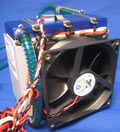 CoolIT
Systems' Freezone
CoolIT
Systems' Freezone employs a water block to transfer heat from the CPU over
to a polypropylene glycol mixture. The heated coolant is then pumped into a heat
exchanger/chiller/reservoir that's cooled by a stack of six thermoelectric
coolers. Liquid-cooling systems normally use a radiator at this leg of the
journey, and they usually rely heavily on the surrounding ambient air
temperature to perform effectively.
Next, a 92mm fan draws air through the heat exchanger, expelling heat out the
rear exhaust port of the chassis. The coolant, which has dropped several degrees
at this point, makes its way back to the (hot) cold plate to begin the process
again. A thermal control module (TCM) regulates the entire cooling enterprise
with sensor feedback to ensure efficiency and prevent condensation.